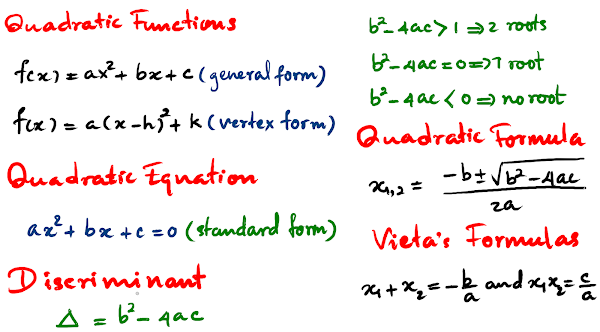- $f(x)=x^{2}+6 x+8$
Given that $f(x)$ can be expressed in the form $(x+A)^{2}+B$ where $A$ and $B$ are constants,- find the value of $A$ and the value of $B$.
- Hence, or otherwise, find
- the value of $x$ for which $f(x)$ has its least value
- the least value of $f(x)$
The curve $C$ has equation $y=x^{2}+6 x+8$
The line $l$, with equation $y=2-x$, intersects $C$ at two points.
- Find the $x$-coordinate of each of these two points.
- Find the $x$-coordinate of the points where $C$ crosses the $x$-axis.
- $f(x)=3 x^{2}+6 x+7$
Given that $\mathrm{f}(x)$ can be written in the form $A(x+B)^{2}+C$, where $A, B$ and $C$ are rational numbers,- find the value of $A$, the value of $B$ and the value of $C$.
- Hence, or otherwise, find
- the value of $x$ for which $\dfrac{1}{f(x)}$ is a maximum,
- the maximum value of $\dfrac{1}{f(x)}$.
-
$f(x)=2 x^{2}-8 x+5$
Given that $f(x)$ can be written in the form $a(x-b)^{2}+c$- find the value of $a$, the value of $b$ and the value of $c$.
- Write down
- the minimum value of $f(x)$
- the value of $x$ at which this minimum occurs.
-
$f(x)=6+5 x-2 x^{2}$
Given that $f(x)$ can be written in the form $p(x+q)^{2}+r$, where $p, q$ and $r$ are rational numbers,- find the value of $p$, the value of $q$ and the value of $r$.
- Hence, or otherwise, find
- the maximum value of $f(x)$
- the value of $x$ for which this maximum occurs.
$g(x)=6+5 x^{3}-2 x^{6}$ - Write down
- the maximum value of $g(x)$,
- the exact value of $x$ for which this maximum occurs.
-
The roots of the equation $x^{2}+6 x+2=0$ are $\alpha$ and $\beta$,
where $\alpha>\beta$. Without solving the equation,
- find
- the value of $\alpha^{2}+\beta^{2}$,
- the value of $\alpha^{4}+\beta^{4}$.
- Show that $\alpha-\beta=2 \sqrt{7}$.
- Factorise completely $\alpha^{4}-\beta^{4}$.
- Hence find the exact value of $\alpha^{4}-\beta^{4}$.
- Given that $\beta^{4}=A+B \sqrt{7}$ where $A$ and $B$ are positive constants find the value of $A$ and the value of $B$.
- find
-
The equation $x^{2}+m x+15=0$ has roots $\alpha$ and $\beta$ and the equation
$x^{2}+h x+k=0$ has roots $\dfrac{\alpha}{\beta}$ and $\dfrac{\beta}{\alpha}$
- Write down the value of $k$.
- Find an expression for $h$ in terms of $m$.
- find the two possible values of $\alpha$.
- Hence find the two possible values of $m$.
Given that $\beta=2 \alpha+1$,
- The equation $2 x^{2}-7 x+4=0$ has roots $\alpha$ and $\beta$ Without solving this equation, form a quadratic equation with integer coefficients which has roots $\alpha+\dfrac{1}{\beta}$ and $\beta+\dfrac{1}{\alpha}$.
-
$f(x)=2 x^{2}-5 x+1$
The equation $f(x)=0$ has roots $\alpha$ and $\beta$. Without solving the equation- find the value of $\alpha^{2}+\beta^{2}$
- show that $\alpha^{4}+\beta^{4}=\dfrac{433}{16}$
- form a quadratic equation with integer coefficients which has roots $\left(\alpha^{2}+\dfrac{1}{\alpha^{2}}\right)$ and $\left(\beta^{2}+\dfrac{1}{\beta^{2}}\right)$
-
The equation $x^{2}+p x+1=0$ has roots $\alpha$ and $\beta$
- Find, in terms of $p$, an expression for
- $\alpha+\beta$.
- $\alpha^{2}+\beta^{2}$.
- $\alpha^{3}+\beta^{3}$.
- Find a quadratic equation, with coefficients expressed in terms of $p$, which has roots $a^{3}$ and $\beta^{3}$.
- Find, in terms of $p$, an expression for
-
- Show that $(\alpha+\beta)\left(\alpha^{2}-\alpha \beta+\beta^{2}\right)=\alpha^{3}+\beta^{3}$.
The roots of the equation $2 x^{2}+6 x-7=0$ are $\alpha$ and $\beta$ where $\alpha>\beta$.
Without solving the equation, - find the value of $\alpha^{3}+\beta^{3}$.
- show that $\alpha-\beta=\sqrt{23}$.
- Hence find the exact value of $\alpha^{3}-\beta^{3}$.
- Show that $(\alpha+\beta)\left(\alpha^{2}-\alpha \beta+\beta^{2}\right)=\alpha^{3}+\beta^{3}$.
-
$f(x)=x^{2}+(k-3) x+4$
The roots of the equation $f(x)=0$ are $\alpha$ and $\beta$.- Find, in terms of $k$, the value of $\alpha^{2}+\beta^{2}$.
- without solving the equation $f(x)=0$, form a quadratic equation, with integer coefficients, which has roots $\dfrac{1}{\alpha^{2}}$ and $\dfrac{1}{\beta^{2}}$
- find the possible values of $k$.
Given that $4\left(\alpha^{2}+\beta^{2}\right)=7 \alpha^{2} \beta^{2}$,
-
$f(x)=x^{2}+p x+7 \quad p \in \mathbb{R}$.
The roots of the equation $\mathrm{f}(x)=0$ are $\alpha$ and $\beta$.- Find, in terms of $p$ where necessary,
- $\alpha^{2}+\beta^{2}$,
- $\alpha^{2} \beta^{2}$.
- find the possible values of $p$.
- form a quadratic equation with roots $\dfrac{2 p}{\alpha^{2}}$ and $\dfrac{2 p}{\beta^{2}}$.
Given that $7\left(\alpha^{2}+\beta^{2}\right)=5 \alpha^{2} \beta^{2}$.
Using the positive value of $p$ found in part (b) and without solving the equation $f(x)=0$,
- Find, in terms of $p$ where necessary,
- The equation $3 x^{2}-5 x+4=0$ has roots $\alpha$ and $\beta$. Without solving this equation, form a quadratic equation with integer coefficients that has roots $\alpha+\dfrac{1}{2 \beta}$ and $\beta+\dfrac{1}{2 \alpha}$.
-
The roots of the equation $x^{2}+3 x-5=0$ are $\alpha$ and $\beta$.
- Without solving the equation, find
- the value of $\alpha^{2}+\beta^{2}$.
- the value of $\alpha^{4}+\beta^{4}$.
- show that $\alpha-\beta=\sqrt{29}$.
- Factorise $\alpha^{4}-\beta^{4}$ completely.
- Hence find the exact value of $\alpha^{4}-\beta^{4}$.
- find the value of $p$ and the value of $q$.
Given that $\alpha>\beta$ and without solving the equation,
Given that $\beta^{4}=p+q \sqrt{29}$ where $p$ and $q$ are positive constants,
- Without solving the equation, find
-
It is given that $\alpha$ and $\beta$ are such that $a+\beta=-\dfrac{5}{2}$ and $\alpha \beta=-5$.
- Form a quadratic equation with integer coefficients that has roots $\alpha$ and $\beta$
- find the value of
- $\alpha^{2}+\beta^{2}$.
- $a^{3}+\beta^{3}$.
- Hence form a quadratic equation with integer coefficients that has roots $\left(\alpha-\dfrac{1}{\alpha^{2}}\right)$ and $\left(\beta-\dfrac{1}{\beta^{2}}\right)$.
Without solving the equation found in part (a),
Monday, September 27, 2021
Subscribe to:
Post Comments (Atom)












0 Reviews:
Post a Comment